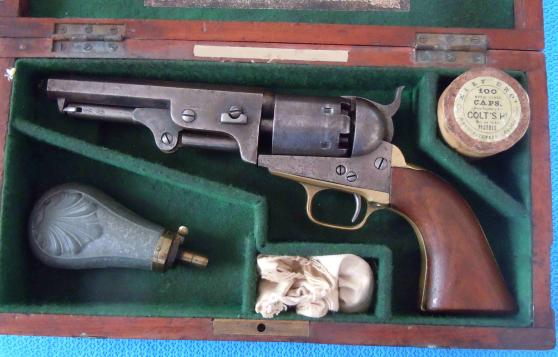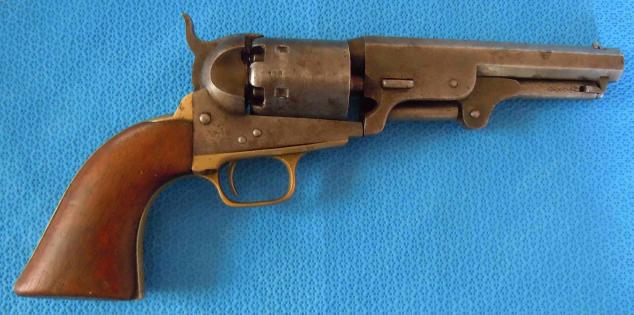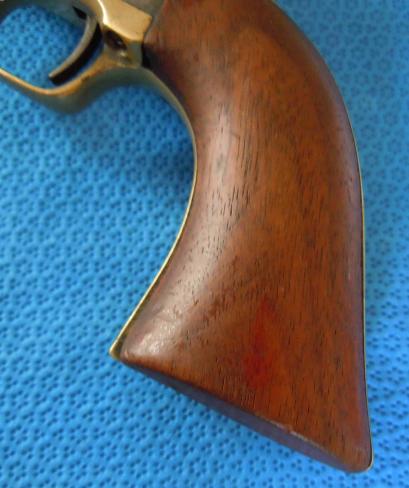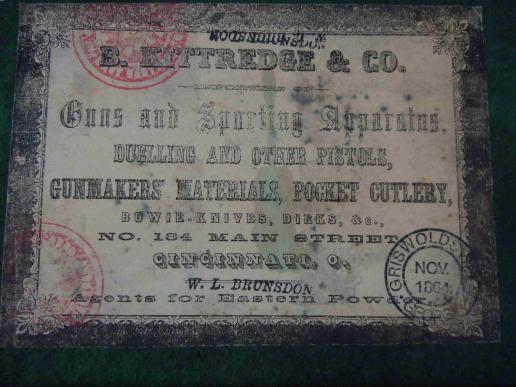Fascinating Civil War Cased Metropolitan Cased Revolver.
This is an extremely interesting cased set, one of the most fascinating Ive offered.
The case is brass bound with side lever military style catch hooks to secure it and contains in addition to the revolver, a contemporary powder flask, cap tin and contents and a calico bag of bullets.
At first glance it appears to be a Colt Navy revolver but actually it is a Metropolitan Arms Company of New York copy produced towards the end of the Civil War. How this revolver came into production was a direct result of the catastrophe that befell Colt.
On February 4, 1864 almost the entire Colt manufacturing plant in Hartford, CT burnt to the ground. Theories abound as to the cause of the fire. Was it an accident or sabotage from Confederate sympathizers, etc.? Whatever the cause, the conflagration left Colt's main building in ruins with its steam engines, parts, patterns, and tools belonging to various contractors destroyed. Millions of dollars were lost and thousands of employees put out of work. To make matters worse, the plant was only partially insured. Sam Colt's widow vowed to rebuild but it would be quite some time before the company was back on its feet and could once again claim its market share of the revolver business.
About this time the Metropolitan Arms Company appeared on the scene. The company, located in New York, took full advantage of Colt's missing product line by producing near-identical copies of the Model 1851 Navy Revolver, the 1861 Navy Revolver, and the 1862 Model Pocket Police from 1864 until 1866...which coincidentally is the year Colt resumed full production. During that two year period, the company manufactured approximately 6,000 copies of the 1851 Navy, fewer than fifty of the 1861 Navy, and 2,750 of the Pocket Police Model.
This revolver is a copy of the 1851 in .36 calibre and many collectors argue that the quality of production exceeded that of Colt. These are scarce revolvers and this is the first Ive offered for many years.
Cased in a brass bound travelling case, what is extraordinary about the revolver is its apparent provenance indicated by stamps on the trade label on the inner case lid and an address stamped into the cylinder. The label has been over stamped Griswolds Georgia Nov 1864 and this is a trade stamp. The original label was for a Cincinnati supplier.
A further name is stamped on the edge of the cylinder which is not quite discernible but the stamping of New Orleans is quite legible.
These revolvers were originally made with a 7.5 barrel length but from time to time shorter barrel lengths are encountered and it is assumed that these were professionally shortened post production to make them easier to holster and handle. This particular revolver has a 6 barrel. Most finish is faded except in some protected areas and the cylinder naval scene is worn but discernible. The cylinder lock up is extraordinarily tight with a sound action. Bore is very good and serial numbers match.
What is intriguing about this revolver is that a Griswold stamp on the trade label is dated November 1864 which is the first year of production of Metropolitan Arms. The trade label is for a Northern Distributor Benjamin Kettridge and has been over stamped with the Griswold trade stamp. The trade label is also stamped W L Brunsdon and the revolver cylinder is also stamped W L Brunsdon New Orleans. Presumably Brunsdon was a retailer of firearms or more than likely a Sutler. Sutlers were people who followed an army selling the troops a range of goods from foodstuffs to equipment including firearms. Possibly one could assume that the case was supplied with a different revolver but then to see the New Orleans stamp on the cylinder tends to negate that assumption. From looking at the stamping with a 600x electric microscope it is clear that the stamping is contemporary to the revolver. My hypothesis is that the revolver was shortened by Kettridge who had supplied Kentucky with arms. Kentucky was a border state that was not part of the Union at the start of the war but was key as recognised by Lincoln who was born there. There is no doubt that Kettridge had strong links with Kentucky and this is a state where literally brother fought brother so it would not be surprising to find arms entering the Confederacy from this State.
This is a real Confederate sleeper that was missed by a UK auction house and dealer and is a fascinating find. How did it get to Georgia in the closing years of the US Civil War? Why was it stamped New Orleans and finally how did it arrive in the UK? The use of the other combatting sides weapons in the Civil War is well documented and arms were captured or ran blockades, both sides for example used Enfield Rifles. I have never heard of a Metropolitan Arms revolver used by the Confederates but it must have happened.
This is a true part of American history that merits further research and would be an exceptional item for any Civil War collector, particularly one who specialised in Confederate arms.
Code: 50493








